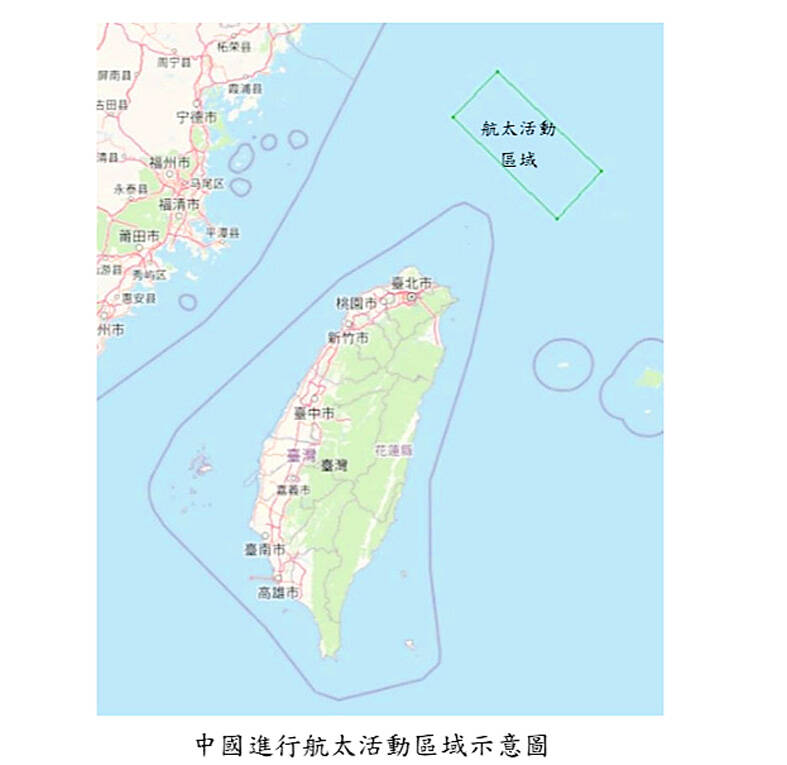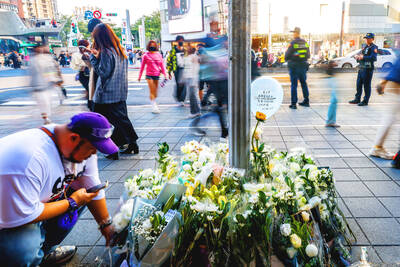China’s short notice that it is to implement a no-fly zone north of Taiwan from Sunday to Tuesday shows its disregard for international rules and poses a threat to regional flight security, experts said late on Wednesday.
Beijing informed Taiwan on Tuesday that it planned to implement a no-fly zone from 9am to 2pm from Sunday to Tuesday for the purposes of “conducting aerospace activities,” the Ministry of Transportation and Communications said.
The ministry said that the short notice given by Beijing, which was less than the standard seven days, flouted international norms and jeopardized flight safety in the area.

Photo courtesy of the Ministry of Transportation and Communications
Amid protests from Taipei, Beijing announced it would reduce the duration to 27 minutes on Sunday, averting wider travel disruption, the ministry said.
The no-fly zone is to be enforced about 85 nautical miles (157km) off the north of Taiwan and within Taiwan’s Taipei Flight Information Region (FIR) and northern air defense identification zone (ADIZ), the military said.
South Korea and Japan, which China also briefed on its plans, said the no-fly zone is being implemented due to concerns over falling debris from a satellite launch.
Before setting up a no-fly zone, China should have issued a notice to air missions, or NOTAM, at least seven days before the set date, aviation safety specialist Peng Szu-ming (彭斯民) said.
While such no-fly zones are normally set up within a country’s territorial space, they sometimes overlap with other countries’ FIRs and ADIZs, said Su Tzu-yun (蘇紫雲), a research fellow at the Institute for National Defense and Security Research.
In such cases, the country in question is required to inform nearby authorities in a timely manner beforehand so that they can make preparations for aviation safety, Su said.
China’s announcement did not follow international rules and Beijing deliberately set up the no-fly zone in the Taipei FIR, one of the busiest flight routes in the area, he said, adding that its actions pose a serious threat to regional and international aviation safety.
Chinese authorities only told Taiwan of the no-fly zone on Tuesday, six days instead of the standard seven days, Deputy Minister of Transportation and Communications Chi Wen-jong (祁文中) said.
China’s behavior showed a disregard for international regulations and norms, Su said, adding that Beijing was using the no-fly zone to attain regional hegemony and assert its claims over Taiwan.
Peng said that despite agreeing to cut short the duration of the no-fly zone, China had already successfully demonstrated to the world its ability to disrupt and block air traffic northeast of Taiwan.
Speaking to Bloomberg, Sung Wen-ti (宋文笛), a specialist on Taiwanese politics and cross-strait relations at Australian National University, said it was unusual that Beijing changed its plan following a complaint from Taiwan.
The change might be a sign of coordination problems within Beijing, he said.
“The aviation agency may have called for a more extended no-fly zone period out of technical necessity, but economic and foreign affairs portfolios subsequently scaled it back to minimize regional pushback,” he said.
The original schedule would have overlapped with the G7 foreign ministers’ meeting in Karuizawa, Japan, that is to be held from Sunday to Tuesday.

SHIPS, TRAINS AND AUTOMOBILES: The ministry has announced changes to varied transportation industries taking effect soon, with a number of effects for passengers Beginning next month, the post office is canceling signature upon delivery and written inquiry services for international registered small packets in accordance with the new policy of the Universal Postal Union, the Ministry of Transportation and Communications said yesterday. The new policy does not apply to packets that are to be delivered to China, the ministry said. Senders of international registered small packets would receive a NT$10 rebate on postage if the packets are sent from Jan. 1 to March 31, it added. The ministry said that three other policies are also scheduled to take effect next month. International cruise ship operators

HORROR STORIES: One victim recounted not realizing they had been stabbed and seeing people bleeding, while another recalled breaking down in tears after fleeing A man on Friday died after he tried to fight the knife-wielding suspect who went on a stabbing spree near two of Taipei’s busiest metro stations, Taipei Mayor Chiang Wan-an (蔣萬安) said. The 57-year-old man, identified by his family name, Yu (余), encountered the suspect at Exit M7 of Taipei Main Station and immediately tried to stop him, but was fatally wounded and later died, Chiang said, calling the incident “heartbreaking.” Yu’s family would receive at least NT$5 million (US$158,584) in compensation through the Taipei Rapid Transit Corp’s (TRTC) insurance coverage, he said after convening an emergency security response meeting yesterday morning. National

PLANNED: The suspect visited the crime scene before the killings, seeking information on how to access the roof, and had extensively researched a 2014 stabbing incident The suspect in a stabbing attack that killed three people and injured 11 in Taipei on Friday had planned the assault and set fires at other locations earlier in the day, law enforcement officials said yesterday. National Police Agency (NPA) Director-General Chang Jung-hsin (張榮興) said the suspect, a 27-year-old man named Chang Wen (張文), began the attacks at 3:40pm, first setting off smoke bombs on a road, damaging cars and motorbikes. Earlier, Chang Wen set fire to a rental room where he was staying on Gongyuan Road in Zhongzheng District (中正), Chang Jung-hsin said. The suspect later threw smoke grenades near two exits

The Forestry and Nature Conservation Agency yesterday launched a gift box to market honey “certified by a Formosan black bear” in appreciation of a beekeeper’s amicable interaction with a honey-thieving bear. Beekeeper Chih Ming-chen (池明鎮) in January inspected his bee farm in Hualien County’s Jhuosi Township (卓溪) and found that more than 20 beehives had been destroyed and many hives were eaten, with bear droppings and paw prints near the destroyed hives, the agency said. Chih returned to the farm to move the remaining beehives away that evening when he encountered a Formosan black bear only 20m away, the agency said. The bear